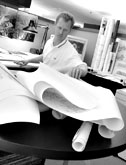
Comment
on this story
 Knoxville by Design Knoxville by Design
The Skies, the Limits
Pondering the future of tall buildings in Knoxville and America
Bungalow People
The low-slung houses that never went away have a new generation of enthusiasts
|
|

What do architects build when they're building for themselves? Photographer David Luttrell visited the offices of four local firms to find out.
Bullock Smith
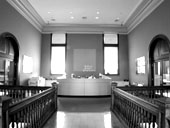
The Southern Railway Station on Depot Street had been vacant for nearly 20 years when Bullock Smith renovated it in 1989. The firm fully restored the building for its own offices, retaining unique features including fireplaces with inscriptions by Scottish poet Robert Burns and coffered ceilings in the former passenger waiting rooms. New paint colors were selected to match the original brick and stone.
McCarty Holsaple McCarty
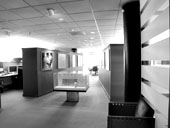
Not only did MHM design its own offices, it also designed the building on Main Street that houses them (along with the Bank of America). MHM associate Stuart Butcher says the firm has been in the building a little over 10 years. "One of the concepts we wanted to have was an open feeling...to foster easy communication of ideas." Low wall partitions separate the work stations, to allow for a combination of private space and free flow of conversation. At the entrance, two display walls splay slightly outward, making them seem both longer and more inviting, drawing visitors in. The openness even extends to office of principal Doug McCarty, who had his door removed.
Barber & McMurry
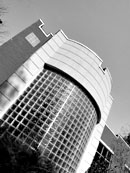
Knoxville's oldest architecture firm sits in surprisingly modern offices on Lindsay Place in near-West Knoxville. The unmistakable glass blocks and walls full of windows combine with sleek lines and open work space for an unfussy elegance.
Ross Fowler
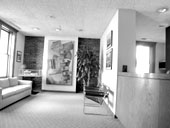
The renovated Ely Building on Church Avenue was originally built as a doctor's office and residence in the late 19th century. Charlie Ross, president of Ross Fowler, says his firm spruced it up and moved in about 16 years ago. They took off the crumbling horse-hair wall plaster and retextured the brick underneath to create a distinctly urban feeling. They retained other elements of the original building, including the elegant staircase banister, but incorporated them into a modern office design. "That's sort of a signature," Ross says. "We made the decision we wanted to be downtown, and that's a statement that we think there is a place for preserving heritage and history architecturally, and we also think there's a place for the contemporary. So this is where it all kind of comes together."

October 25, 2001 * Vol. 11, No. 43
© 2001 Metro Pulse
|





